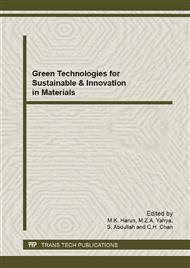p.280
p.285
p.290
p.296
p.305
p.313
p.320
p.325
p.331
Study on Fabrication of Ceramic Membrane from Shirasu Balloon for Waste Water Filtration
Abstract:
The fabrication of low cost ceramic membranes for microfiltration were studied by using a natural materials (shirasu balloon) which are produced from glassy volcanic materials. The shirasu powder was formed into cylindrical shaped membranes and sintered at five different temperatures from 600 °C to 800 °C using spark plasma sintering (SPS). The porosity and density of membranes were measured according to Archimedes method. The effect of sintering temperatures on microstructure and phase of the membranes has been investigated using FESEM and XRD. A filtration experiment was carried out to study the membrane performance for waste water filtration. The quality of the filtered water was determined by analyse the pH, turbidity, suspended solid, chemical oxygen demand (COD) and biochemical oxygen demand (BOD5). The porosity reduced from 48.9% to 40.32% while the membrane density increased from 1.15 g/cm3 to 1.33 g/cm3 with increasing sintering temperatures from 600 °C to 800 °C. A little shrinkage occur during spark plasma sintering process. From the FESEM microstrcture, the maximum pore size of the membrane that has been observed at 600 °C is about 4.7 µm. Shirasu membrane are able to produce clean and clear treated water during the microfiltration test with membrane sintered at 800 °C and there is an improvement in quality of water that has been filtered. The ceramic water filter was successfully produced without the involvement of the high-tech, sophisticated machines and methods as well as complex materials
Info:
Periodical:
Pages:
305-310
Citation:
Online since:
April 2013
Price:
Сopyright:
© 2013 Trans Tech Publications Ltd. All Rights Reserved
Share:
Citation:



